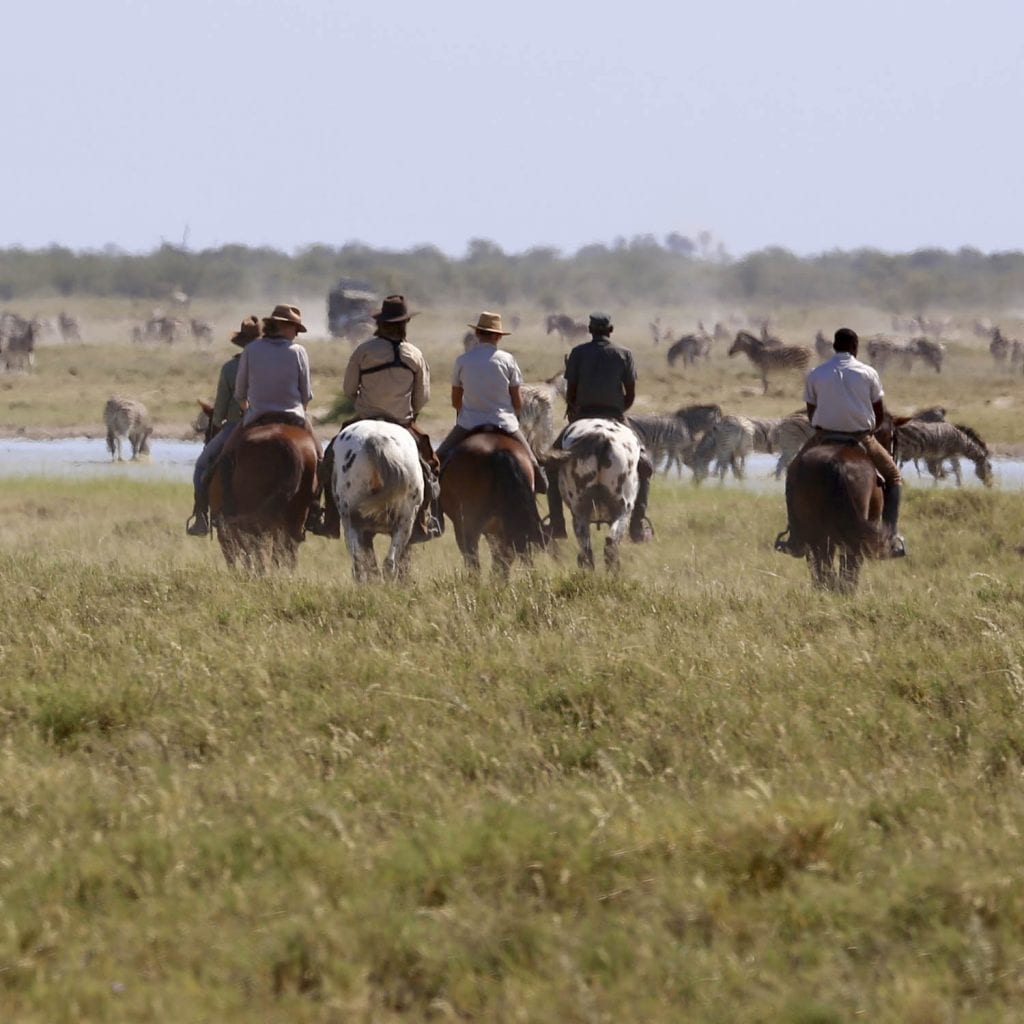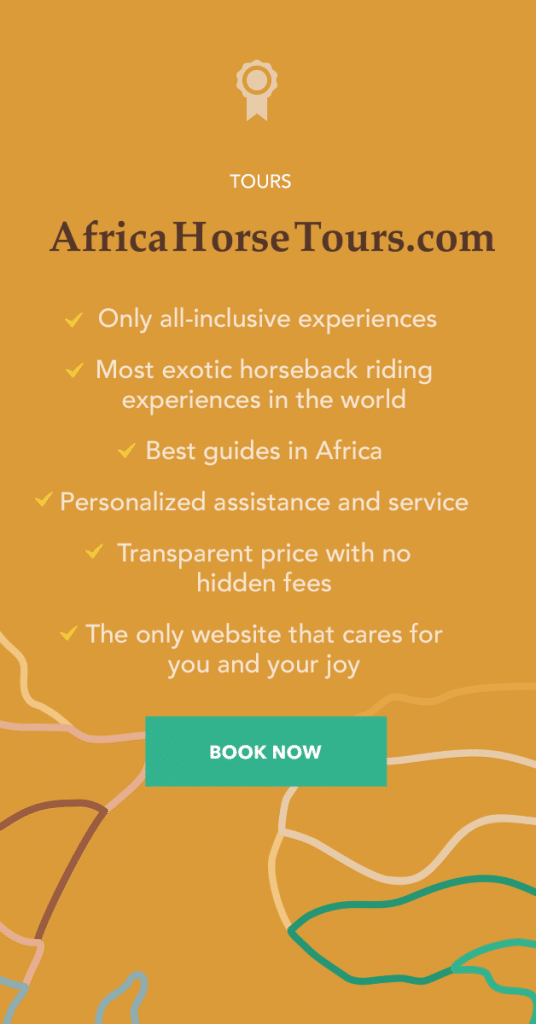The journey is divided in two: first, the Okavango delta, where we will be at the mercy of whimsical tides and weather changes; afterwards, the meadows and dunes of Kalahari invite us to submerge in Africa in a different way.
Full Experience Okavango & Kalahari
 13 Days
13 Days
TYPOLOGIES
botswana
DIFFICULTY
Medium
MIN. AGE
USD 10,656

Cavalcade in the delta, meadow and dunes, an unbeatable combination.
Location
Botswana
Duration
13 Days / 12 Nights
Season
January - December
Horses
Cross breeds which include Shire/TB, Boerperd/TB, Friesian/BP, Arab crosses, Quarter horse crosses.
The Riding
4 – 7 hours per day
Package specifications
![]() Travel cancellation insurance
Travel cancellation insurance
![]() Breakfast and dinner included
Breakfast and dinner included
![]() Health care included
Health care included
Services NOT included
![]() Lunch not included in the package
Lunch not included in the package
![]() Baggage protection insurance
Baggage protection insurance
Photo Gallery
























Day by day
Day 1. Welcome
From the airport of Maun, we are only 30 minutes away by car to the South side of Okavango, where the safari begins in a place known “buffaloes area”. Here, the horses are waiting; the luggage is loaded in mekoro canoes and is transported to the camp while the guest ride and venture on their horse in the Delta.
Day 2. First encounter with elephants.
To explore this water desert on a horse is, no doubt, unforgettable, especially the first encounter with elephants, an experience that would not be remotely the same if we did it from a car. Before the sun sets, we ride to an isolated camp in a beautiful remote island.
Day 3. It depends.
What we do that day depends on water levels, the moves of the wild fauna and the duration of the safari. Nevertheless, each place is exquisite since there is a great variety of islands covered by the shades projected by the trees.
Day 4. Ancient elephant paths.
We wake up early in the morning and have a light breakfast around the bonfire, at dawn. We spend the morning over the horse, following old elephant paths looking for a variety of wildlife, enjoying the prolific life of the birds and going around the plains recently flooded.
Day 5. Giraffes, buffaloes and antelopes lurk around.
Pack of buffaloes may be close to us, the giraffes lurk around and the Lechwe antelopes splash water over us, while the kudu watches us from the bushes. We head back to the camp to have lunch and take a nap under the shade of big dense trees. We take a night tour to think, listening to the sounds of bushes, and the wheeze and splashing of the horses. Afterwards, we get back to the camp and have dinner under the stars.
ay 6. Outing in mokoro canoes.
DIt all depends on the water level and the weather. There is a chance that, if permitted by the conditions, we may take a quiet outing in mokoro canoes, a traditional way to go through he lakes and fluvial ways, all brilliant and full of lilies. It is also a chance to submerge in an adventure and walk in order to appreciate the little creatures that inhabit the mount or learn some rudimentary tracking skills.
Day 7. Either on a horse, on mokoro, or on foot.
The way in which we go around the delta depends on the water level. The delta forces us to adapt to the circumstances, to look for the better way to move around: either on the horse, in mokoro or on foot, we go forward. In any event, the camp goes with us floating on a mokoro.
Day 8. Heading towards the salt pans.
We start relaxed, either on foot or by a short sailing trip, we then travel by plane to the Makgadikgadi salt pans. The new camp is simple but comfortable: it has a straw-bale library, a living room and a pool to freshen up. In the afternoon, we go to an introductory ride to get in tune with our horses and take a look around the area. We then have dinner and put aside our horses, in a safe place, before lions get out to make their night round.
Day 9. Dunes and salt pans, ideal to go around on a horse and spot fauna.
At dawn, we have a light breakfast and have a long stroll over the morning through the “Land of the Thousand Island”. Stranded in the bed of the old lake, the sand dunes covered by palm trees are one of the most beautiful and fascinating places in the Botswana desert. The island and pastures nearby are loaded with zebras, wildebeest, hares and ostriches, and, of course, predators accompanying them. The mountains of salt among the island make it a great place to go around with our horses. In the afternoon, we return and find refuge under the shade to avoid the sun. We can use the pool. We then get out to spot the species typical from this arid area, such as gazelles and hyenas. At night, we get back in pickups in the middle of the night. The lanterns light the animals that cross over the road and that we cannot spot during daylight.
Day 10. Baobabs and the millenary origin.
Today we travel East, to the Xau Xai camp. We leave the salt pans and penetrate the mopan and acacia woods, next to the vast meadows that allow us to speed up and gallop towards the horizon. It is possible that we see Kudu along the way, and maybe some elephants. At lunch time, we reach the Baobab wood, called like that for its millenary and magnificent baobabs trees. We have lunch. If we really pay attention, we will find objects from the Stone age. This is not weird: after all, we are where humankind originated, the beginning of everything. We then continue our journey until we reach the camp, we rest there, lying on the floor, connecting with the star and nature.
Day 11. Searching for meerkats.
Searching for meerkats. We get up to a steaming cup of coffee and prepare ourselves to go out in the search of meerkats. We go on foot given that this is a protected species. Meerkats are not docile by nature, but they got used to human contact. For instance, it is possible that on a cold day, one of them curl up against our body. We watch them interact between them, moving, controlling the environment. It is one of the most extraordinary experiences in Botswana. We get back to our horses and ride: we are now looking for zebras and ostriches that drink water from hidden wells. At sunset we take advantage of the outlook that extends upon us: 16 thousand km of savannah, vegetation, animals, sky and horizon.
Day 12. Return.
We pass by the salt pans, along the meadows. Our horses ask us to gallop with intensity, to look for areas where they can give free rein to their will. As the sun starts to go down on the horizon, and light starts to vanish, we make sure to stop in these places where a few days ago we discovered part of Africa. We can repeat the location twice, but never time, which moves forward at an even pace. And this is the way our horses are, feeling the need to move forward along the meadows. We reach the Kahari camp and relax beneath the stars.
Day 13. Native people and farewell.
Today we walk. We look for the Zu/’Hoasi community, an ancient tribe that tell us part of their history: we are taught how they have survived in this hostile environment, using their vast and ancient knowledge on plants, the behaviour of animals and their surviving skills. After lunch, we say goodbye Makgadikgadi and we return to Maun on a plane.





